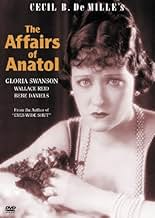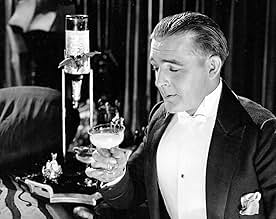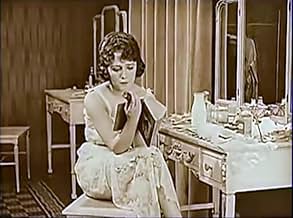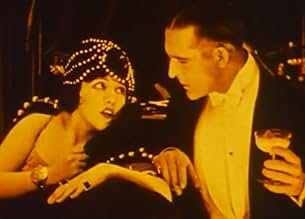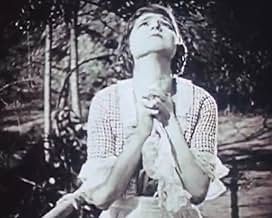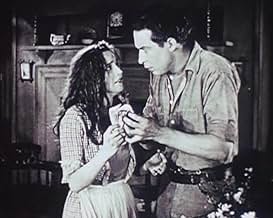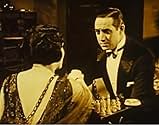IMDb RATING
6.6/10
1.4K
YOUR RATING
Socialite Anatol Spencer seeks a better relation than he has with his wife. He sets up the friend of his youth Emilie in an apartment and she two-times him; he comforts near-suicidal Annie a... Read allSocialite Anatol Spencer seeks a better relation than he has with his wife. He sets up the friend of his youth Emilie in an apartment and she two-times him; he comforts near-suicidal Annie and she robs him.Socialite Anatol Spencer seeks a better relation than he has with his wife. He sets up the friend of his youth Emilie in an apartment and she two-times him; he comforts near-suicidal Annie and she robs him.
- Director
- Writers
- Stars
- Awards
- 1 win total
Laura Anson
- Vivian's Maid
- (uncredited)
Alma Bennett
- Chorus Girl
- (uncredited)
William Boyd
- Guest
- (uncredited)
Shannon Day
- Chorus Girl
- (uncredited)
Julia Faye
- Tibra
- (uncredited)
Elinor Glyn
- Bridge Player
- (uncredited)
Winter Hall
- Dr. Johnston
- (uncredited)
Raymond Hatton
- Great Blatsky - Violin Teacher
- (uncredited)
Fred Huntley
- Stage Manager
- (uncredited)
- Director
- Writers
- All cast & crew
- Production, box office & more at IMDbPro
Featured reviews
Drawn to this by the irresistable and rare chance of seeing Wallace Reid and Gloria Swanson working together on a film, I had heard about it through reference books (and also about Swanson's recollections of the film not being happy due to feeling uncomfortable with Reid at the time), and expected exactly what I got - a fun piece with some nice touches (Gloria's playful mood before she feels slighted by Wanda Hawley's flapper girl; Reid trashing Hawley's apartment when he realises she did not have pure intentions towards him after all; Agnes Ayres and Reid sharing a kiss in the woods while Gloria has gone to fetch a doctor to attend to Ayres, 'half-drowned' when she left; and best of all, Bebe Daniels as the absurdly named Satan Synne who is really a domesticated pussy cat chasing young men for cash to help her sick husband). The Affairs ... also benefits from having a lovely series of colour tints throughout. A little overlong perhaps (and too much focus on Hawley at the expense of the other girls encountered by Tony) but another fascinating early piece from De Mille. Sad to think that Wallace Reid would be dead by early '23. The movies' loss.
An interesting document of almost one hundred years ago. Your enjoyment of this will obviously depend on whether you like silents or not. As a look way back to the beginnings of narrative film making and a fashion show of what woman wore then this has some interest. Gloria is unquestionably the star and she holds the screen with no problem. A renown clotheshorse her outfits are bizarre in the extreme to the modern eye but were the height of high fashion in their day. It's also a rare chance to see the doomed Wallace Reid in one of his few existing films. He was deep in the throes of the morphine addiction that would kill him within two years when this was made and looks shockingly old when you realize he was only 29 at the time, he appears 50 minimum.
Wallace Reid (as Anatol Spencer) is a wealthy newlywed who is oddly attracted to various women other than his wife - specifically: Wanda Hawley (as Emilie), Agnes Ayres (as Annie), and Bebe Daniels (as Satan Synne!). Gloria Swanson (as Vivian) is the wife who seems to develop a roving eye of her own as the running time progresses. BUT, are "The Affairs of Anatol" really affairs, or just a series of titillating temptations?
DeMille's work with mirrors is on display, with the director inserting a skeleton image of Mr. Reid in one scene. Reid was a very big star when this film was released (one of the most popular actors in the world); and, though this isn't really representative, it's nice to see him. Of the leading ladies, I enjoyed Ms. Ayres over the others, because her simple scenes with Monte Blue seem so ORDINARY when contrasted with the rest of the goings-on.
DeMille's unlikely mix of titillation, religiosity, and heavy-handed message is obviously in full flower. While there are no performances for the ages, the scenes with Swanson being hypnotized by Theodore Kosloff are fun. Elliott Dexter (as Max Runyon) is the film's best supporting actor; keep a sharp eye on his closing scenes as he'll reveal, through his performance, the affair you might not have been expecting
****** The Affairs of Anatol (9/25/21) Cecil B. DeMille ~ Wallace Reid, Gloria Swanson, Bebe Daniels, Elliott Dexter
DeMille's work with mirrors is on display, with the director inserting a skeleton image of Mr. Reid in one scene. Reid was a very big star when this film was released (one of the most popular actors in the world); and, though this isn't really representative, it's nice to see him. Of the leading ladies, I enjoyed Ms. Ayres over the others, because her simple scenes with Monte Blue seem so ORDINARY when contrasted with the rest of the goings-on.
DeMille's unlikely mix of titillation, religiosity, and heavy-handed message is obviously in full flower. While there are no performances for the ages, the scenes with Swanson being hypnotized by Theodore Kosloff are fun. Elliott Dexter (as Max Runyon) is the film's best supporting actor; keep a sharp eye on his closing scenes as he'll reveal, through his performance, the affair you might not have been expecting
****** The Affairs of Anatol (9/25/21) Cecil B. DeMille ~ Wallace Reid, Gloria Swanson, Bebe Daniels, Elliott Dexter
This film is great fun, and often -- and I think intentionally, as in the 'Satan Synne' segment -- very funny: "an extravagant story that never by any chance could be taken seriously," as one contemporary reviewer approves. It's hard to sympathise with spoiled wife Vivian at first (a hard-edged performance by Gloria Swanson), but as the film goes on we start to realise that she does have a point.
This being a de Mille film, the costumes are of course fantastic; although it's actually not Swanson, the famous 'clothes-horse', who gets the best dresses here. Production values are elsewhere very high, as well, extending into beautifully-drawn title cards (in one case, with a live-action car actually driving across it!) and a lot of sacrificed furniture, while frankly, those jewelled flowers look almost worth losing a lover over...
But it's not all gloss and enjoyable silliness. There's some fine acting on display as well, not least from Wallace Reid as the well-meaning 'Tony' whose halo begins progressively to slip -- and, in a couple of telling little scenes, from Elliott Dexter as the overlooked best friend. (The little scene over the chessboard is a perfect illustration of the power of the silent screen: everything made explicit without a word.)
The picture's stage heritage shows up mainly in a few over-long title cards, where plot points are conveyed in one long 'speech'; at almost two hours in duration, it's also unbalanced in the direction of the first half, which could almost stand as a film on its own without its briefer 'sequels'. If Emilie is not to have a film of her own, there is perhaps a little too much time devoted to her.
But "The Affairs of Anatol" is well worth seeing -- not least, as an eye-opener for those like myself who associate C.B. de Mille with vast Biblical epics. This piece of froth and frivolity has more of the charm of a Harold Lloyd movie minus the slapstick; one can really see why 'handsome Wallace Reid' was a star; and there are just enough well-judged moments of genuine feeling among the spectacle and satire to make us care about the various minor players.
This being a de Mille film, the costumes are of course fantastic; although it's actually not Swanson, the famous 'clothes-horse', who gets the best dresses here. Production values are elsewhere very high, as well, extending into beautifully-drawn title cards (in one case, with a live-action car actually driving across it!) and a lot of sacrificed furniture, while frankly, those jewelled flowers look almost worth losing a lover over...
But it's not all gloss and enjoyable silliness. There's some fine acting on display as well, not least from Wallace Reid as the well-meaning 'Tony' whose halo begins progressively to slip -- and, in a couple of telling little scenes, from Elliott Dexter as the overlooked best friend. (The little scene over the chessboard is a perfect illustration of the power of the silent screen: everything made explicit without a word.)
The picture's stage heritage shows up mainly in a few over-long title cards, where plot points are conveyed in one long 'speech'; at almost two hours in duration, it's also unbalanced in the direction of the first half, which could almost stand as a film on its own without its briefer 'sequels'. If Emilie is not to have a film of her own, there is perhaps a little too much time devoted to her.
But "The Affairs of Anatol" is well worth seeing -- not least, as an eye-opener for those like myself who associate C.B. de Mille with vast Biblical epics. This piece of froth and frivolity has more of the charm of a Harold Lloyd movie minus the slapstick; one can really see why 'handsome Wallace Reid' was a star; and there are just enough well-judged moments of genuine feeling among the spectacle and satire to make us care about the various minor players.
The Affairs of Anatol (1921)
A long, involved, romantic and slightly moralizing movie about a really good hearted man caught between two women. That's the reason to watch it, that and Gloria Swanson in the lead as the wife. The other woman (Wanda Hawley) is a bit of a siren, and our good fellow is trying to be a charitable fellow with her, and only gets himself in trouble. She plays him like a child.
The year, 1921, is just at the point where the silent film is solidifying and getting sophisticated in a modern sense. There is still a lot of static (fixed) camera in this one (even though one of the photographers was the legendary Karl Struss). This puts the emphasis on the acting, which rises to the occasion. The copy I saw had some great hand colored title cards and some scenes that were toned in rich yellows or other colors, which made it all quite fun. The conflict between the two women, and the intrusion of another man or two, make this a classic soap opera kind of drama, well done and clear enough to follow once you get the basic flow. There are sort of two halves, and the second part out in the country is a nice shift even though the theme remains similar.
Of interest? The director, Cecil B. De Mille, had a hugely influential and long career, and this is toward the beginning, and it shows his tendency to find the popular themes that audiences would connect with, rather than push technical or aesthetic boundaries. Some might call him a populist, interest above all in success, but he was an expert director who knew how to make a movie really coherent, handling the story and actors with precision and a sympathetic feel. And the subject matter here is actually a bit edgy--a married man hanging out with a woman in her most intimate spaces. The play of the "bad" woman against the "good" one is a little expected, of course, but it's such a heartwrenching problem for this nice guy who just wants to help (or so he says), it's painfully enjoyable to watch.
A long, involved, romantic and slightly moralizing movie about a really good hearted man caught between two women. That's the reason to watch it, that and Gloria Swanson in the lead as the wife. The other woman (Wanda Hawley) is a bit of a siren, and our good fellow is trying to be a charitable fellow with her, and only gets himself in trouble. She plays him like a child.
The year, 1921, is just at the point where the silent film is solidifying and getting sophisticated in a modern sense. There is still a lot of static (fixed) camera in this one (even though one of the photographers was the legendary Karl Struss). This puts the emphasis on the acting, which rises to the occasion. The copy I saw had some great hand colored title cards and some scenes that were toned in rich yellows or other colors, which made it all quite fun. The conflict between the two women, and the intrusion of another man or two, make this a classic soap opera kind of drama, well done and clear enough to follow once you get the basic flow. There are sort of two halves, and the second part out in the country is a nice shift even though the theme remains similar.
Of interest? The director, Cecil B. De Mille, had a hugely influential and long career, and this is toward the beginning, and it shows his tendency to find the popular themes that audiences would connect with, rather than push technical or aesthetic boundaries. Some might call him a populist, interest above all in success, but he was an expert director who knew how to make a movie really coherent, handling the story and actors with precision and a sympathetic feel. And the subject matter here is actually a bit edgy--a married man hanging out with a woman in her most intimate spaces. The play of the "bad" woman against the "good" one is a little expected, of course, but it's such a heartwrenching problem for this nice guy who just wants to help (or so he says), it's painfully enjoyable to watch.
Did you know
- TriviaGloria Swanson admitted in an interview decades later that Wallace Reid's drug addiction scared her while they were making this film, and she avoided socializing with him because of it.
- GoofsIn the flashback sequence where Emilie is on a swing and two mirrors are set up to give repeated reflections of the action, the cameraman bending over his camera is visible a few times when the swing moves out of the way.
- Quotes
Anatol Spencer: Let's not kiss any more, dear, until after breakfast.
- Alternate versionsFilm Preservation Associates copyrighted a version in 1999 with a music score compiled and performed by Brian Benison. It was produced for video by David Shepard and ran 117 minutes.
- ConnectionsEdited into Don't Tell Everything (1921)
Details
- Release date
- Country of origin
- Language
- Also known as
- Anatol: Five Kisses
- Production company
- See more company credits at IMDbPro
- Runtime1 hour 57 minutes
- Sound mix
- Aspect ratio
- 1.33 : 1
Contribute to this page
Suggest an edit or add missing content

Top Gap
By what name was The Affairs of Anatol (1921) officially released in Canada in English?
Answer
